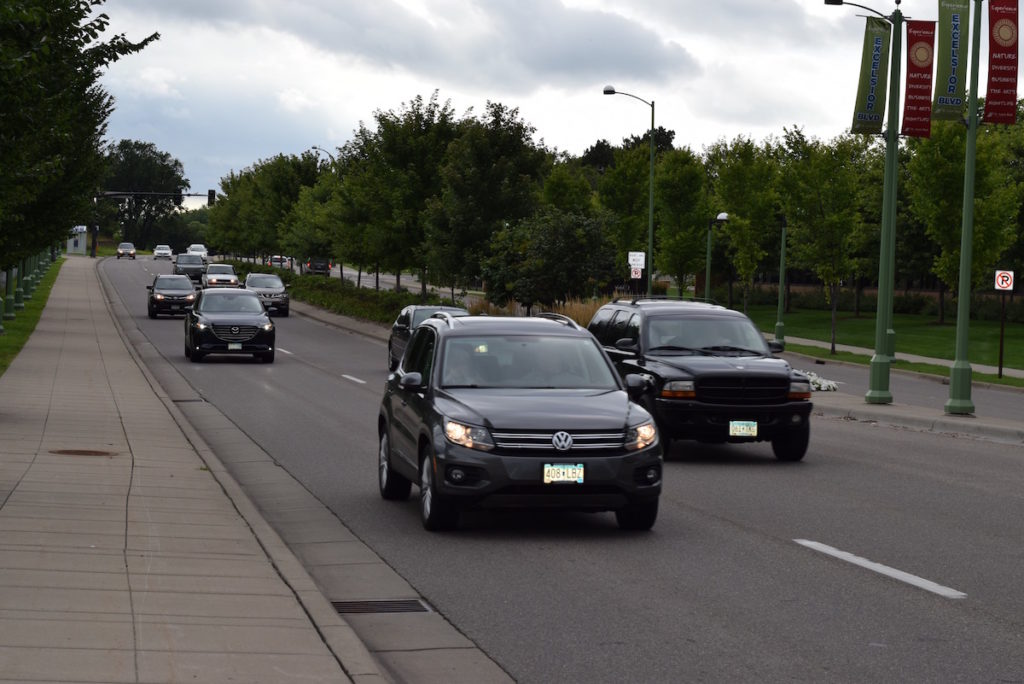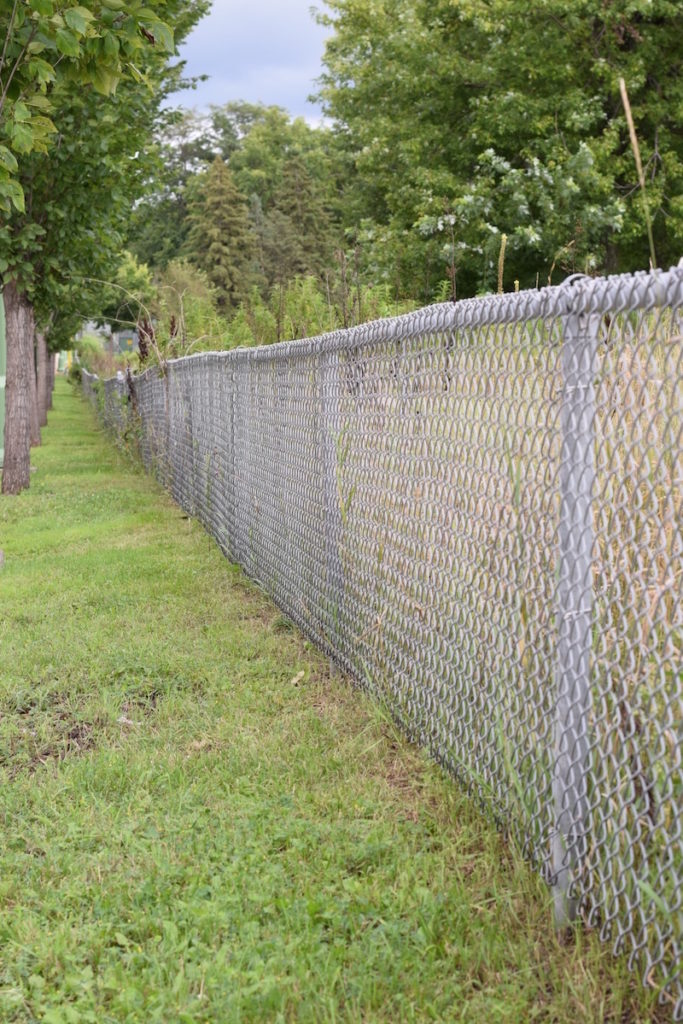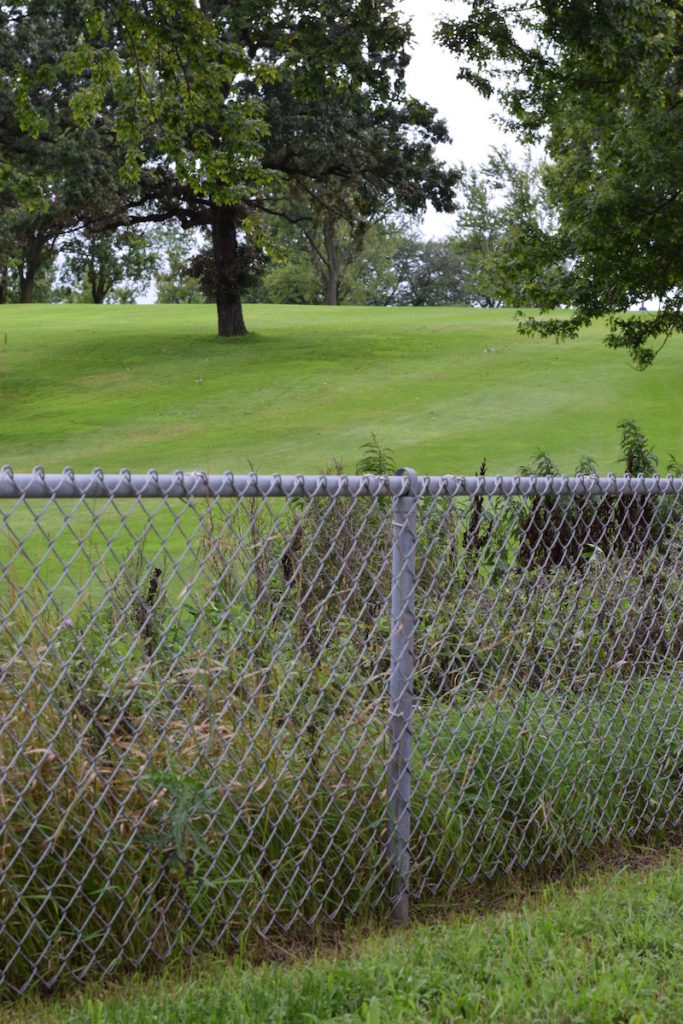by Jon Mobeck, JHWF Executive Director
This is a little story about a deer and a fence in Minneapolis, Minnesota, where I am today.
I was driving down busy Excelsior Boulevard when I saw a doe and fawn gallop across two lanes, then a tree-lined median, then two more lanes and a sidewalk before the doe leapt over a short woven-wire fence that marked the boundary of a golf course. The fawn, however, had no idea how to do what its mother had just done. While at a stoplight, I watched the fawn slam face-first into the short fence, then scamper along the fence line for a hundred yards or so before smashing its nose into the wire again.

The fence is at far left of this picture of busy Excelsior Boulevard.
When the light turned green, I did a quick u-turn and pulled to the side of the shoulderless road. I activated my hazard lights and jumped out of the car to see if I could capture the fawn and help it over the fence – or at least shepherd it several hundred yards west to a gap in the fence. Neither of these things proved easy to do. The first few times I approached, the fawn blitzed by me racing full speed along the fence line before pausing to make another headlong charge into the woven wire. After many of the failed ramming efforts, the fawn would dart crazily back out into traffic. Although traffic was moving at about 45 mph on that stretch, the fawn fortunately found gaps as it darted about. It never crossed over the median again, always returning for another charge at the fence. Slam! Crash! The doe stood tall on the opposite side of the fence, and mirrored the fawn’s movement east and west along the fence. During all of this time, the fawn rarely ceased bleating, while the doe communicated in brief, huffing pleas.

For almost a quarter-mile, the fence was unbroken.

It was about 30 inches high.
As I tried, unsuccessfully, to shepherd or catch this panicked fawn, a young woman came running down the sidewalk toward me. She wanted to help. Without discussing strategies, we assumed the positions of border collies and tried to surround the fawn from opposite sides and “corner” it against the fence, hoping for a chance to catch it. This almost worked, but the fawn squeezed past the woman and darted back onto the road, except now the traffic had stopped, with the two lanes backed up, recognizing what was taking place and thankfully waiting for resolution. After we both watched the fawn race along the fence and slam into it a few more times, thinking it would never slow down, and never stop panicking, the fawn did slow down, and it did seem to stop panicking for a few seconds. It trotted back down the boulevard toward us and as it approached, it walked slowly toward the fence and stopped right between me and the woman. We formed a triangle with the momentarily calm fawn at top near the fence. We slowly stepped toward it and the fawn turned along the fence toward the woman and made a little leap as if to run, jumping (kind of miraculously) right into the woman’s arms, where she easily lifted it over the fence and set it down on the other side. It scampered away in a rush. The doe did not chase after it, but stood very erect, vocalizing. The doe stamped its feet, and took a few measured steps toward the crazed fawn, which was running endlessly, and in circles. After a few moments, the fawn slowed, and then galloped toward its mother.
I don’t know what happened to those deer after that moment, but they were safe for now. The woman and I high-fived each other. She remarked that she was a little worried that she might get kicked. I was impressed by her skill in corralling the bounding fawn in one giant bear hug, her willingness to risk injury, and her desire to help in the first place. Her car was pulled behind mine, also with its hazard lights flashing.
As we were high-fiving, we heard car horns honking in approval. A woman leaned from the driver seat toward the open passenger window to shout “thank you!” A man in a garbage truck yelled “good job!”
Although I sometimes hear people reprimand those who “anthropomorphize” wildlife, it’s impossible to witness an event such as this one and not understand the emotions, the stress, the communication, the concern experienced by a mother and its offspring. They are navigating this planet with us. We are sharing a life that will end with each of us representing a miniscule segment of the unfathomable span of history. No life is more important than any other.
At JHWF, we talk about creating permeable landscapes. We aren’t necessarily focused on how many animals die because of fences, or even how high our fences are – any uninterrupted fence can be a problem. We focus our efforts on how well we are ensuring that the large and small animals can move across a landscape we share with them. Where can and should we create gaps in a fence, for passage above and below? How can animals navigate our development, our neighborhoods, our roadways? A community that lives compatibly with wildlife considers these things daily.
Thanks to hundreds of volunteer heroes, the Wildlife Friendlier Fencing program has removed or modified 188 miles of fence, including nearly five miles this summer. A lot of fawns and calves have had an easier time because of this work. We often think about the height of a fence in relation to how high we know an adult deer or elk can jump. The story of a young whitetail deer in Minneapolis tells us we might benefit by expanding our thinking.
Next Saturday, August 26, we have a project in Game Creek on hillsides frequented by deer and elk. It’s a fence with three barbed wires and a top rail. It’s not hard to imagine a fawn approaching such a fence and trying to ram through it, as was the preference for the fawn in Minneapolis. If the bottom wire is high enough from the ground, the fawn might be able to sneak under, but in a panicked state with developing legs and unrefined navigation skills, it may not make it. So how many fawns and calves get separated from their mothers because of the barriers we raise?
Despite these concerns, what I’m left with after my experience with the deer and the fence in Minneapolis is the potential of people to do good things, to be of service to others, to embrace ethics that connect people with each other and to the wild things that live upon the same land. We have incredible potential, despite the degree to which our more suspicious natures question the goodness of people – a reflection of an increasingly skewed version of reality that focuses on every isolated negative activity within oceans of good deeds done daily, if quietly.
The young woman who stopped to help me inspires me, although I never learned her name. She took a few minutes out of her day to get a deer over a fence. The people who stopped their cars, those who honked, those who cheered and thanked us, they represent the better angels of our nature. We live in a world with beautifully wild things, and we are they.
